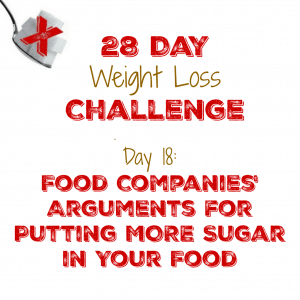Over the course of our 28 Day Weight Loss Challenge our Daily Recap videos will be where I post the notes I have written for the talks I do in the FaceBook Group each night. Hopefully this will make what we are talking about easier to follow for everyone that wants to join us in the challenge. You can see each of the 28 Day Challenge recap posts here. Please subscribe to the YouTube channel to never miss an video.
So yesterday we looked at how the food industry justifies adding sugar to our foods, today we are going to look at some of the arguments they use to say that adding sugar, especially fructose, is a perfectly natural or even a good thing.
#1 Fructose doesn’t raise Blood Sugar – Fructose has a very low glycemic index which means it doesn’t raise blood sugar when eaten but fructose is never found without glucose, whether in nature or in HFCS. So any time you eat anything with fructose, you are also eating glucose which does cause an insulin spike and raises blood sugar but at the same time that is happening, fructose is directly causing an increase in fat deposits around the liver which makes insulin resistance worse. Essentially, every time you eat sugar you are eating a fat and and a carb at the same time.
#2 We Should switch out Glucose for Fructose – The Food Industry wants to create a purely fructose sweetener to use instead of sugar or HFCS but have been unable to get FDA approval. The reason is because that while fructose doesn’t raise blood sugar levels it appears to bind with cellular proteins and do damage within the cells of your body. An increase in fructose consumed would make this problem worse. Does anyone remember Olestra? A fat substitute that was supposed to revolutionize the food industry by enabling us to totally get rid of fat in our food. Except Olestra couldn’t be absorbed by our body and usually just came leaking out the other end. It looks like pure fructose has the same problems of absorption and might cause the same issues.
#3 All the Info You Need is On The Food Label – Starting soon we will be able to read the “Added Sugar” amounts on food labels to help us figure out how much added sugar is in the food we eat. Remember, it’s not the sugar that occurs naturally in foods that are the problem because these are usually small amounts and mitigated by the natural fiber in the food. For instance, eating a whole peach is ok but eating a canned peach will give you a huge hit of sugar because it is canned in sweet syrup. For a long time, the added sugar info wasn’t available to us but at least now we can make a better informed decision about our food.
#4 We are filling a need – The food industry would like for us to believe that they are just filling a demand. People want more salt, fat, and sugar and they want it in larger serving sizes so that’s what the food industry gives us. But this isn’t true, the food industry creates demand with an incessant marketing campaign designed to drive desire. Next time you watch TV, count how many of the commercials are for food. Now think about how many commercials you’ve seen in your lifetime for whole foods. Ever see a commercial of an apple? How about celery? These marketing campaigns are with us from birth and designed to push us towards those unhealthy foods for a lifetime.
This marketing is targeted especially at kids and there is no place they are safe from their message. Most schools have soda machines the kids can access at any time and the schools will sign exclusive contracts with soft drink companies to keep those machines full and to put their label on everything. Down here in the south you would be hard pressed to find a scoreboard without a Dr Pepper logo on it. And that’s from Elementary to College.
Now food companies are rebranding their junk food as healthy. You can buy soft drinks with real cane sugar instead of HFCS as if somehow that is good for you. You can get baked chips and whole grain granola bars that are still full of sugar. Don’t believe the advertising, processed food is almost by definition junk food despite what the buzzwords on the packaging tell you.
All notes taken from information found in Fat Chance by Dr Lustig, Good Calories, Bad Calories by Gary Taubes, Grain Brain by Dr Perlmutter, The Angriest Trainer Podcast andJimmy Moore’s Podcasts.
Don’t miss a post! Click here to sign up for our daily email!



